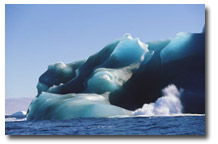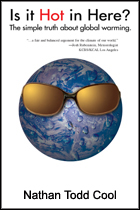GreehouseTruth Blog :: Climate Roundup 2006

|
|
|
|
|
Climate Roundup 2006
A look at this year's global climate
Posted December 31, 2006 by Nathan Cool
 In 2005--a year when Tookie Williams was executed, Pope John Paul II passed away, London felt the deadly wrath of four Islamic militants, and cable news disgraced itself by airing nonstop footage of a comatose, brain-dead Terry Schiavo under the dubious guise of "analysis"--Katrina became a household word and the tune of global warming began to ring rather audibly in the ears of many as experts labeled 2005 the warmest year on record. But 2006 will likely be remembered as "the year of the climate" as a firestorm of "breaking news" occupied front-page headlines, talk shows recruited eco-pundits, and "the full story at 11:00" TV teasers became evermore annoying--a trend that was seemingly sparked by an ex U.S. presidential candidate's mission to save the planet from our insatiable appetite for energy, oil, and ostensible disregard for the byproducts created from our fossil-fueled, carbon compulsions.
In 2005--a year when Tookie Williams was executed, Pope John Paul II passed away, London felt the deadly wrath of four Islamic militants, and cable news disgraced itself by airing nonstop footage of a comatose, brain-dead Terry Schiavo under the dubious guise of "analysis"--Katrina became a household word and the tune of global warming began to ring rather audibly in the ears of many as experts labeled 2005 the warmest year on record. But 2006 will likely be remembered as "the year of the climate" as a firestorm of "breaking news" occupied front-page headlines, talk shows recruited eco-pundits, and "the full story at 11:00" TV teasers became evermore annoying--a trend that was seemingly sparked by an ex U.S. presidential candidate's mission to save the planet from our insatiable appetite for energy, oil, and ostensible disregard for the byproducts created from our fossil-fueled, carbon compulsions.
Sitting well poised on the edge of our proverbial seats, waiting for more climate catastrophes to occur, it became in vogue to blame each and every weather event this past year on the human-induced, warming state of Mother Earth--and for good reason. We had a doosey of a heat wave in July, drought continued around the world, forest fires were reportedly getting more frequent and worse, massive amounts of polar ice had disappeared, meteorologists signaled an impending El Niño, and hurricane experts forewarned that another year of intense tropical storms would likely batter the east and gulf coasts of the U.S. Now that 2006 has come to an end, and not even one hurricane came close to hitting the shores of the red white and blue, and the winter has remained relatively quiet for a large part of the U.S., were we worried for naught? Were the weather extremes of 2005 to be the climatic waves of the future that never came to pass? Or was an exaggerated fury whipped up by a pulpiteering politician creating fear and mass hysteria?
Fishing through all the white noise and media-chatter has been a challenge this past year to get to the root of our planet's climate change predicament. Luckily though, upon panning for gold in a stream running rampant with global warming hyperbole, nuggets of truth have been found, and from the most reliable sources at our disposal.
Recently, NOAA's National Climatic Data Center (NCDC) released its preliminary, 2006 annual report, which analyzes the climate events from around the globe. This report is where the proverbial rubber meets the road, and where science gets its say in what did or did not occur this past year. The truth isn't always pretty, but in many cases, it isn't all that inconvenient either.
According to the NCDC report, global warming didn't come to an abrupt halt, but it didn't necessarily take a drastic turn for the worse either. As of this report, the global annual average temperature over both land and ocean surfaces was the sixth warmest on record at 0.94°F above normal, with 2005 still holding the record high of 1.10°F above normal, leaving 2006 as a somewhat cool year in comparison to other years so far this millennium. The above average temps we did see in 2006 were primarily due to warmer than normal Northern Hemisphere temperatures; the Southern Hemisphere remained cooler, and has yet to break its 1998 record of 0.97°F anomalous.
Still, warmer than average temperatures occurred throughout most of the land areas of the world. The largest anomalies were present throughout high latitude regions of the Northern Hemisphere including much of North America, Scandinavia, China and Africa. Temperatures in these regions were 3.6-7.2°F above the 1961-1990 average. The only widespread area of negative anomalies occurred in Russia, including one cold snap in January when Moscow temperatures plummeted to -22°F--the coldest readings since the winter of 1978-1979, when temperatures dropped to -36°F. Additionally, India had some chilly days with frost observed in New Delhi for the first time in 70 years when cold air flowing from the Himalayas produced a low temperature of 32.3°F on January 9th--a day likely difficult for residents of India's capital to believe that global warming was afoot.
Precipitation seemed to follow suit with expectations of a warming world this past year: wet regions did get wetter, and dry regions even drier. Global precipitation in 2006 was much higher than the 1961-1990 average--the largest value in five years. Arid conditions though were widespread across the U.S. Great Plains and Gulf Coast regions, the western coast of Canada and most of Australia this past year. Also, a severe long-term drought continued throughout southern Ethiopia, southern Somalia, northeastern Kenya, as well as adjacent areas of eastern Uganda and Tanzania for most of 2006. In February, drought in Somalia was characterized as the worst in a decade. In all, an estimated 11 million people in East Africa and the Horn of Africa continued to face critical food shortages--a trend that will likely continue and worsen.
In a warmer and subsequently moister world, snowfall can also be enhanced. While 2006 did see above average snowfall, it was still only a fraction of the copious amounts of fluffy white stuff that fell in 1978, and even slightly less than 2005. Charleston, SC and Savannah, GA though saw the earliest snowfalls on record for those regions in November 2006, and New York City endured a record 24-hour snowfall during a blizzard in February.
Despite these wintertime, snowfall anomalies, worldwide sea ice continued to decline with 5.9 million square kilometers left as of September 14, 2006--the second lowest on record. This is the fifth consecutive year that the September measured sea ice has been below the long-term, 1978-2000 average. The sea ice decline is now almost 9 percent per decade (60,421 square kilometers per year). From January to mid-July 2006, the sea ice extent was well below the record set just last year. However, in August, temperatures near the poles were a few degrees cooler than average--a seemingly unexpected twist in the global warming story that inhibited further melting. Confusing this matter even further, the Dec. 27 issue of the journal Science explained that although Greenland and Antarctica were losing ice at a rapid pace in 2006, the current ice sheet losses are not raising sea levels any faster. And now, many more issues have come into question, including the possibility that natural variations (like the dip in August temperatures) could slow down the progression of melting. Or will the ice sheets begin to adjust to the new warmth that's accelerated their demise as of late? Or will things get worse? These questions, as of the end of 2006, remained unanswered.
On a brighter note, the 2006 hurricane season was officially classified as "near-normal." Even though experts warned coastal residents to hunker down and prepare for the worst, 2006 tropical activity in the Atlantic was much milder than most other seasons. Nine, the number of named storms during the 2006 Atlantic hurricane season, is the second lowest since 1995--the 1997 season had even fewer named storms. Reduced activity in these years is attributed largely to the rapid onset of El Niño in the equatorial Pacific, which suppresses conditions conducive to hurricane formation in the Atlantic. The frequency and intensity of El Niño events though could spell trouble for climate change, acting as a bellwether of a warming world. Still, this year's El Niño is relatively mild compared to previous years (and decades).
While the U.S. hurricane season remained ho-hum, there were other strong storms this past year including Typhoon Durian in November that killed some 1,200 people in the Philippines. Typhoon Saomai in August battered the coast of China, reportedly as the strongest storm to hit the region in 50 years (not ever, just in the past five decades). Yet Typhoon Ioke, which luckily steered clear of land, became the strongest Central Pacific hurricane ever recorded with winds clocking in at nearly 162 mph. Yet the South Pacific tropical cyclone season was one of the weakest ever with only three storms, and only one being cyclonic.
Despite the benign hurricane season in the Atlantic, severe weather was quite noticeable this past year across the U.S. In Washington State, a parade of Pacific winter storms caused severe flooding and the wettest November on record. Alaska and Hawaii also saw record-breaking precipitation levels this past year. Wildfires, enhanced from excessive drought, burned 9.5 million acres across the West, and I don't think any of us will soon forget the heat wave that gripped most of the country in July, breaking the West's record for the warmest summer--nationwide though it was the second warmest in the past 112 years.
While much of the data presented throughout this past year may seem contradictory, apocalyptic, or just down right confusing, consensus continued to grow and action ensued. Aside from the media hype and Al Gore's crusade on the climate, there have been some fairly even-handed reviews this past year that bolster the belief that we humans are at least partly responsible for contemporary climate change. The Pew Center provided a new report in September that provides strong evidence that greenhouse gases released by human activities could be the main cause of global warming in recent history. The U.S. Supreme Court has gotten involved as well, listening to arguments from a dozen states that the EPA needs to regulate greenhouse gas emissions and enforce these emissions as they do pollutants. California got serious though this year with Assembly Bill 32--the California Global Warming Solutions Act--which seeks to roll back the clock on greenhouse gas emissions to 1990 levels. Its companion bill from the state Senate, SB 1368, stops energy providers from making new commitments for coal-fired energy as well.
As 2006 fades into memory, 2007 marks the beginning of a new era. What exactly this new epoch will be remembered for is yet to be known. While we can't see into the future, we can look at our past. Signs do seem to point toward a warming world, yet as 2006 proved quite well, the extent to which things will change and how humankind will be affected is still a postulation of the possible. Many of the climatic events that took place around the world this past year could be viewed as zero-sum, where catastrophes in one region were balanced by benefits elsewhere. Yet creeping normalcy from harmful harbingers such as the loss of sea ice could be interpreted as the proverbial swan song of Mother Earth. Even though climate science is a burgeoning field and surprises of both good and bad are becoming more frequent, maybe all of us, no matter what our views on global warming, could make a resolution this New Year for improvement. Perhaps then, 2007 would be remembered as the year when our generation took action--whether for the climate, our country's security, economic stability or energy independence, we cutback on fossil fuels, strived for green technologies, and took steps to reduce our greenhouse gas emissions. After all, it couldn't hurt, could it?
|
To stay abreast on similar articles like this, you can signup for the free GreenhouseTruth newsletter. Additional information on El Niño, climate events, global temperatures, sea ice extent and other topics discussed in this blog can be found in Nathan Cool's new book, Is it Hot in Here?--The simple truth about global warming. Click here to get your copy. |

|
